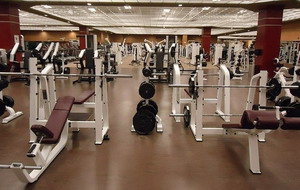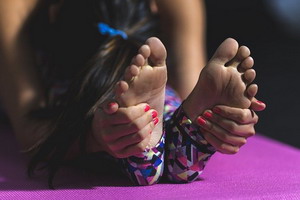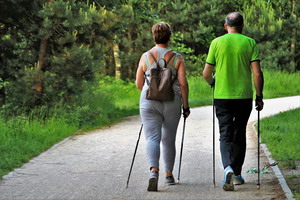 As gyms and classes start opening up again after being closed down for almost a year, I am getting more questions about what exercises folks should do to recover from a year of not exercising. I am getting more people coming in with minor injuries from getting more physically active since the last couple of weekends have been so beautiful. So between new gardens and yoga classes, many folks are feeling what happens when you remain inactive for too long. As everyone knows by now, the body runs on the “use it or lose it” principle. The survival mechanism built into the body is to always conserve energy. This is because through most of human history food was scarce. This meant that survival was a constant balancing act between maintaining body functions while reducing the need for food. Any function that your body concludes you are not needing for survival right now, it stops feeding. It decides need based on how often do you use that function. So if you lift 10 pounds several times a day, your body will feed enough muscles to be able to do that. If you try to lift 50 pounds only once a month, the body figures you don’t really need to be doing that since the challenge comes up so infrequently.
As gyms and classes start opening up again after being closed down for almost a year, I am getting more questions about what exercises folks should do to recover from a year of not exercising. I am getting more people coming in with minor injuries from getting more physically active since the last couple of weekends have been so beautiful. So between new gardens and yoga classes, many folks are feeling what happens when you remain inactive for too long. As everyone knows by now, the body runs on the “use it or lose it” principle. The survival mechanism built into the body is to always conserve energy. This is because through most of human history food was scarce. This meant that survival was a constant balancing act between maintaining body functions while reducing the need for food. Any function that your body concludes you are not needing for survival right now, it stops feeding. It decides need based on how often do you use that function. So if you lift 10 pounds several times a day, your body will feed enough muscles to be able to do that. If you try to lift 50 pounds only once a month, the body figures you don’t really need to be doing that since the challenge comes up so infrequently.
 The important message from this understanding is that we must challenge our body frequently to keep it in shape. Working out once a month is basically worthless. Many studies have been done to see just how often we need to challenge our bodies, and the results vary depending upon which functions we are talking about. In general, however, the average need is to challenge the body every three to five days. This is true for bone strength as much as muscle mass as long as these tissues are at least used normally every day. This caveat becomes critical when normal use is not available, like in zero gravity situations on the space station, or when someone is confined to bed. Many years ago a study was performed confining a group of men to bed for two weeks. They then studied how much strength and coordination they lost. In two weeks they lost 50% of their strength and a huge amount of coordination. Half the men were rehabilitated and the other half sent home to recover on their own. Thirty years later they retested these men and the impact of the bed confinement was still measurable – less in the men that had been rehabbed, but it still showed compared to the control group that was not confined to bed but still measured. This shows you how much we need to be using our bodies all the time.
The important message from this understanding is that we must challenge our body frequently to keep it in shape. Working out once a month is basically worthless. Many studies have been done to see just how often we need to challenge our bodies, and the results vary depending upon which functions we are talking about. In general, however, the average need is to challenge the body every three to five days. This is true for bone strength as much as muscle mass as long as these tissues are at least used normally every day. This caveat becomes critical when normal use is not available, like in zero gravity situations on the space station, or when someone is confined to bed. Many years ago a study was performed confining a group of men to bed for two weeks. They then studied how much strength and coordination they lost. In two weeks they lost 50% of their strength and a huge amount of coordination. Half the men were rehabilitated and the other half sent home to recover on their own. Thirty years later they retested these men and the impact of the bed confinement was still measurable – less in the men that had been rehabbed, but it still showed compared to the control group that was not confined to bed but still measured. This shows you how much we need to be using our bodies all the time.
 The next question is how much of a challenge do we need to stay fit? How intensely do we need to work out? With muscles that means pushing your muscles to their limit a couple of times a week. That is not as bad as that sounds. If you are performing a bodyweight exercise or lifting a weight, the idea is to use that muscle to a point of fatigue or failure. When I am doing super slow exercises I will reach fatigue in about eight reps, so it takes about a minute with each exercise. For bone strength in the hips, you need to push three to four times your body weight for 10 seconds a few times a couple of times a week. Endurance requires similar training, pushing yourself to fatigue a couple of times a week. For maintaining balance, doing several balance exercises a couple of times a week will keep things at a status quo. Significant stretching follows a similar pattern. What is special about this timing? Every time you do something that pushes you to your personal limit, you communicate to your body that you need to function to at least this level of ability. But at your limit, tiny micro-injuries occur in the tissues being worked. It is the chemicals that are released in the injury that tell the body to build or restructure the tissues. These injuries take two to three days to heal. This is where the twice-a-week timing comes from in the body – the time the body needs to heal from micro-injuries.
The next question is how much of a challenge do we need to stay fit? How intensely do we need to work out? With muscles that means pushing your muscles to their limit a couple of times a week. That is not as bad as that sounds. If you are performing a bodyweight exercise or lifting a weight, the idea is to use that muscle to a point of fatigue or failure. When I am doing super slow exercises I will reach fatigue in about eight reps, so it takes about a minute with each exercise. For bone strength in the hips, you need to push three to four times your body weight for 10 seconds a few times a couple of times a week. Endurance requires similar training, pushing yourself to fatigue a couple of times a week. For maintaining balance, doing several balance exercises a couple of times a week will keep things at a status quo. Significant stretching follows a similar pattern. What is special about this timing? Every time you do something that pushes you to your personal limit, you communicate to your body that you need to function to at least this level of ability. But at your limit, tiny micro-injuries occur in the tissues being worked. It is the chemicals that are released in the injury that tell the body to build or restructure the tissues. These injuries take two to three days to heal. This is where the twice-a-week timing comes from in the body – the time the body needs to heal from micro-injuries.
 How much is too much? If you are in a great deal of pain for a couple of days after your workout then you have done too much for maintenance. Professional athletes, dancers, and weight lifters do experience this type of regular pain as they are always pushing for more ability. But for us regular folks, a little muscle stiffness or soreness is all we want to expect.
How much is too much? If you are in a great deal of pain for a couple of days after your workout then you have done too much for maintenance. Professional athletes, dancers, and weight lifters do experience this type of regular pain as they are always pushing for more ability. But for us regular folks, a little muscle stiffness or soreness is all we want to expect.
 You can exercise every day, stretch every day, and do balance activities every day within your normal range of comfort. This should not produce micro-injuries that need healing. This is only a concern when you push to your limit in order to tell your body how much you want to be able to do. So regular comfortable activities are where we are designed to live 99% of the time. The uncomfortable pushed-to-the-limit activities tell our body just what limits we want to have. For instance, if all you lift with your right arm is 10 pounds max, in short order 10 pounds is all you will be able to lift. If you want to be able to increase your strength, or flexibility, or balance, you have to push yourself a little further into your uncomfortable zone repeatedly to tell your body to adapt to the increased demand you want it to do. This is what weight lifters do as an obvious example. But in reality, this is what everyone does to improve their performance in any physical task – regularly challenging the body to do a little bit more than it can presently do. This is called training or practice.
You can exercise every day, stretch every day, and do balance activities every day within your normal range of comfort. This should not produce micro-injuries that need healing. This is only a concern when you push to your limit in order to tell your body how much you want to be able to do. So regular comfortable activities are where we are designed to live 99% of the time. The uncomfortable pushed-to-the-limit activities tell our body just what limits we want to have. For instance, if all you lift with your right arm is 10 pounds max, in short order 10 pounds is all you will be able to lift. If you want to be able to increase your strength, or flexibility, or balance, you have to push yourself a little further into your uncomfortable zone repeatedly to tell your body to adapt to the increased demand you want it to do. This is what weight lifters do as an obvious example. But in reality, this is what everyone does to improve their performance in any physical task – regularly challenging the body to do a little bit more than it can presently do. This is called training or practice. Years ago I took martial arts training. One of the basic “exercises” was to simply sit on the floor and bend forward. The idea was to slowly touch our toes. My hamstring muscles in the back of my legs were so tight and shortened I could barely reach below my kneecaps when my legs were completely flat against the floor. I did this exercise several times a week for a full year. By the time the year came to an end, I could wrap my hands around my feet and rest my head on my legs. I was never comfortable doing this stretching exercise because I was always pushing my limit. But my limits expanded. On the flip side, once I stopped training at that school and stopped doing that stretch regularly, the flexibility I had gained in my hips and legs went right back to where it was before I started that class. I had stopped asking my body to flex that much, so it regressed down to what I was regularly asking it to do.
Years ago I took martial arts training. One of the basic “exercises” was to simply sit on the floor and bend forward. The idea was to slowly touch our toes. My hamstring muscles in the back of my legs were so tight and shortened I could barely reach below my kneecaps when my legs were completely flat against the floor. I did this exercise several times a week for a full year. By the time the year came to an end, I could wrap my hands around my feet and rest my head on my legs. I was never comfortable doing this stretching exercise because I was always pushing my limit. But my limits expanded. On the flip side, once I stopped training at that school and stopped doing that stretch regularly, the flexibility I had gained in my hips and legs went right back to where it was before I started that class. I had stopped asking my body to flex that much, so it regressed down to what I was regularly asking it to do. As I have said many times before, there are no plateaus in health. We are either building abilities or losing them. Unfortunately what this means on a very practical level is that if you are trying to stay comfortable all the time, you are sliding downhill. Just maintaining your health means regularly pushing into uncomfortable territory. Growing or increasing ability calls for a lot more pushing into the uncomfortable. This reality is not what people want to hear, even though they already know this from experiencing life. So many people are looking for the magic pill that will take away the “work” of staying healthy. (I see work as that demand to do stuff that does not feel good and that I don’t really want to do.) I would rather play and enjoy life, doing things I like to do, like my practice. What I am grateful for is that pushing into the uncomfortable zone only needs to be engaged maybe 1% of the time, and I can enjoy the benefits the other 99% of the time.
As I have said many times before, there are no plateaus in health. We are either building abilities or losing them. Unfortunately what this means on a very practical level is that if you are trying to stay comfortable all the time, you are sliding downhill. Just maintaining your health means regularly pushing into uncomfortable territory. Growing or increasing ability calls for a lot more pushing into the uncomfortable. This reality is not what people want to hear, even though they already know this from experiencing life. So many people are looking for the magic pill that will take away the “work” of staying healthy. (I see work as that demand to do stuff that does not feel good and that I don’t really want to do.) I would rather play and enjoy life, doing things I like to do, like my practice. What I am grateful for is that pushing into the uncomfortable zone only needs to be engaged maybe 1% of the time, and I can enjoy the benefits the other 99% of the time. The bottom line here is to embrace the need to step into doing a little bit of uncomfortable stuff regularly to keep strength, flexibility, and balance an ongoing part of your life. I see a big part of the aging process happening simply because when people get older they want to be comfortable. They stop challenging their bodies. Without that challenge, everything goes down the tubes, and health is lost. The good news is that you can reengage the challenge process at any time. You can rebuild with sufficient work (meaning doing the uncomfortable stuff.) I have many examples of folks in their 80’s that are in excellent physical shape because of regularly challenging themselves with activities like running, yoga, bicycling, tennis, golf, or hiking. The list goes on and on. I also have lots of folks of all ages that are in terrible shape because their lifestyle involves no physical challenges. Their lives are all about sitting in front of a computer, or television, or gaming console. They think that by staying comfortable that they are avoiding pain. But the truth is, they have way more pain than the physically active folks have… at least in my experience with patients.
The bottom line here is to embrace the need to step into doing a little bit of uncomfortable stuff regularly to keep strength, flexibility, and balance an ongoing part of your life. I see a big part of the aging process happening simply because when people get older they want to be comfortable. They stop challenging their bodies. Without that challenge, everything goes down the tubes, and health is lost. The good news is that you can reengage the challenge process at any time. You can rebuild with sufficient work (meaning doing the uncomfortable stuff.) I have many examples of folks in their 80’s that are in excellent physical shape because of regularly challenging themselves with activities like running, yoga, bicycling, tennis, golf, or hiking. The list goes on and on. I also have lots of folks of all ages that are in terrible shape because their lifestyle involves no physical challenges. Their lives are all about sitting in front of a computer, or television, or gaming console. They think that by staying comfortable that they are avoiding pain. But the truth is, they have way more pain than the physically active folks have… at least in my experience with patients.